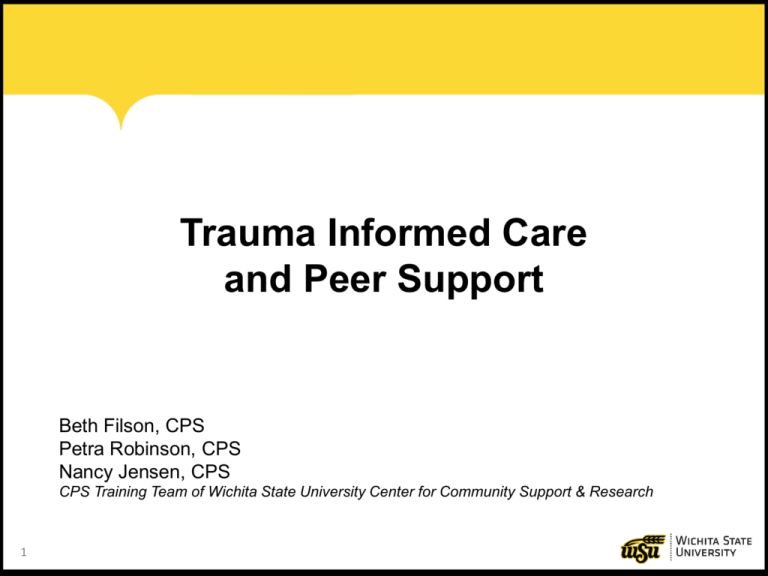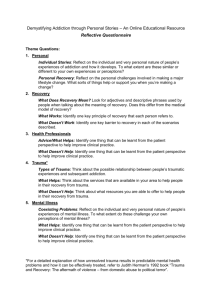
Trauma Informed Care
and Peer Support
Beth Filson, CPS
Petra Robinson, CPS
Nancy Jensen, CPS
CPS Training Team of Wichita State University Center for Community Support & Research
1
Three Quotes – Three Perspectives on Trauma:
• “It’s not mental illness per se…It doesn’t have its roots in
clinical understanding and brain chemistry science.”
• Mary Blake, Trauma Peer Expert Meeting July 2008
• “I didn’t experience trauma, and not all the people I work
with did either, so how is this relevant?”
• Certified Peer Specialist – Trauma Informed Peer Support, 2009
• “Trauma is a social and community issue, not an individual
issue; one that impacts community development and the
quality of our communities…It confounds meaning of
universal experience---love, hate, happiness, justice…how
we see each other. Trauma and healing are profoundly
social events.” Susan Salasan, CMHS Dare to Transform, 2008
2
Refresher on Terms:
Recovery:
“Recovery is the process of gaining control over one’s
life, and the direction on wants their life to go – on the
other side of a psychiatric diagnosis, and all of the
losses usually associated with a psychiatric
diagnosis.”
Appalachian Consulting Group, Inc.
3
Refresher on Terms:
Mental Illness:
The combined impact of stigma, symptoms, and side
effects of medications on one’s sense of self.
Appalachian Consulting Group, Inc.
4
What Is Trauma?
Trauma shapes and informs our interactions with ourselves
and others. It has a profound impact on our body, mind
and spirit, often resulting in isolation, disconnection,
learned helplessness, shame, rage, self-loathing and
adverse physical conditions, including addiction.
Traumatic events can be shocking, and terrifying. These
events can include violence between people, abuse of any
kind, neglect, institutionalization, disasters or war. Trauma
often involved betrayal by a trusted person or institution.
Healing from trauma is possible for all. The experience is
transformative.
The Transformation Center - www.transformation-center.org
5
The Adverse Childhood
Experience Study (ACE)
Led by Robert F. Anda, MD, MS, and Vincent J. Felitti,
MD
Center for Disease Control (CDC) and Kaiser Permanente.
The largest scientific research study of its kind, analyzing
the relationship between multiple categories of childhood
trauma (ACEs), and health and behavioral outcomes later
in life.
For more information go to www.acestudy.org
6
ACE Findings:
Compiled by Joan Gillece, PhD joan.gillece@nasmhpd.org
•
Adverse Childhood Events (ACEs) have serious
health consequences.
• Adoption of health risk behaviors as coping
mechanisms:
– eating disorders, smoking, substance abuse, self
harm, sexual promiscuity
• Severe medical conditions: heart disease,
pulmonary disease, liver disease, STDs, GYN
cancer and early death.
(Felitti et al., 1998)
7
Adverse Childhood Experiences Defined:
1. Recurrent physical abuse
6. Someone who is chronically
depressed, mentally ill or
2. Recurrent emotional abuse
institutionalized, or suicidal
3. Contact sexual abuse
7. Mother is treated violently
4. An alcohol and/or drug
abuser in the household
5. An incarcerated household
member
8
8. One or no parents
9.
Emotional or physical
neglect
Does Trauma Matter?
Does it matter in the mental
health system? Two (or maybe
more) stories.
9
What’s Wrong with the Person?
10
What happened to this person?
11
What does this person need?
12
Trauma Informed Systems of Care
TIC changes the question from “What’s
wrong with you?” to “What happened to you?”
13
What’s in a Name?
The Behavioral Health Care System
When behavior is seen as a symptom of the illness , the
focus of services is on changing the way people act. But
what happens if what I’m doing (how I behave) is how I
am surviving?
14
A Mental Health System is Trauma Inducing When….
Trauma experience is not addressed – either staff’s or the person
in services.
Services and interventions are re-traumatizing – for staff and
person receiving services.
All or most of the person’s behavior is interpreted as symptom
rather than adaptation or how a person has learned to live in the
world, or survive.
There are prominent and unrecognized symbols of power and
authority throughout the center.
Treatment programs are coercive , punitive, do not offer choice.
15
…Trauma Inducing when…
The person receiving services is blamed for the behavior that
is used to assert medical necessity.
Disabling beliefs about what it means to live with a diagnosis
- both staff and the person identified with a diagnosis are
reinforced in program environments.
Goals are not written by the person and do not relate to the
needs the person has including the need for safety.
The resources, supports, and skills that are being taught are
not relevant to what the person wants to achieve.
The community and other systems of support are not Trauma
Informed.
16
Trauma Informed Systems of Care
• Defined – Trauma informed systems of care
operate out of the awareness of the prevalence
and the impact of trauma in the lives of most
people receiving services in the public mental
health system.
• TIC systems recognize that trauma is central to
(not in addition to) the issues that impact a person
in recovery. This awareness is reflected in all its
policies, procedures and practices.
•
17
Example: “Seclusion and restraint is treatment failure.”
NASMHPD Position Statement on Seclusion and Restraint
- www.nasmhpd.org
What Is Re-Traumatization?
• Let’s take a look at a trauma-inducing mental health
system.
• If It’s creating new trauma, what is it doing for people who
have already experienced trauma?
18
Trauma Specific
• Trauma specific services – deal directly with
trauma experience –
• -examples TREM, DBT, EMDR, one –onone or group therapy, etc.
• The focus is on the experience and the
resulting impact.
19
What’s UP With That!!?
• Consumers, psychiatric survivors and expatients now talk openly and frequently
about owning our own recovery from
mental illness….
• …But why don’t we talk openly and
frequently about owning our recovery and
healing from the impact of trauma?
20
When You Change the Question to:
“What happened in your life..?” - you
change the conversation-
21
What was seen as “maladaptive
behavior” is often revealed to be
how someone survived.
22
We are the Stuff of Our Own Transformation
The process of personal transformation begins in the place of our
greatest loss, our deepest grief, our most abject fear. It is rooted in
the place we thought of as utterly useless, a total waste. But we
affirm that we have always carried in us who we were intended to
be, and what our lives are intended for. Transformation is the
natural progression of Becoming; becoming never ends. It begins
the moment we choose to engage in creating and re-creating the life
we want to live – and we do this in relationship to one’s self, others,
and to whatever we think of as our spirit. There is no room for
regret in our transformed lives.
We believe in personal transformation. Transformation takes place
because we are using all that we are and all that we have ever
been, and every one of our experiences. Transformation is what
happens when we come together to engage in intentional
relationships of healing and hope.
23
B. Filson – GA Peer to Peer Trauma
Initiative , 2005
National Center for Trauma Informed Care
The National Center for Trauma Informed Care (NCTIC)
is the technical support center of the U.S. Department of
Health and Human Services, Substance Abuse and
Mental Health Services Administration, Center for Mental
Health Services. It is funded under contract to the
National Association of State Mental Health Program
Directors NASMHPD).
http://mentalhealth.samhsa.gov/nctic/
24
Prevalence of Trauma
• 90% of people served in the public mental health system
have been exposed to trauma. (Mueser et al., 2004, Mueser
et al., 1998) Most have multiple experiences of trauma.
(Mueser et al., 2004, Mueser et al., 1998)
• 97% of homeless women with severe mental illness have
experienced severe physical & sexual abuse – 87%
experience this abuse both in childhood and adulthood
(Goodman et al., 1997)
• American study of 100 adolescent inpatients; 93% had
trauma histories and 32% had PTSD; 70-90% incarcerated
girls – sexual, physical, emotional abuse.
(DOC, 1998, Chesney & Sheldon, 1991)
25
Prevalence of Trauma
• Up to two-thirds of men and women in SA treatment report
childhood abuse & neglect.
SAMSHA CSAT, 2000)
• Study of male veterans in SA inpatient unit - 77% exposed to
severe childhood trauma, 58% history of lifetime PTSD.
(Triffleman et al., 1995)
• 50% of women in SA treatment have history of rape or incest
(Governor's Commission on Sexual and Domestic Violence,
Commonwealth of MA, 2006)
26










